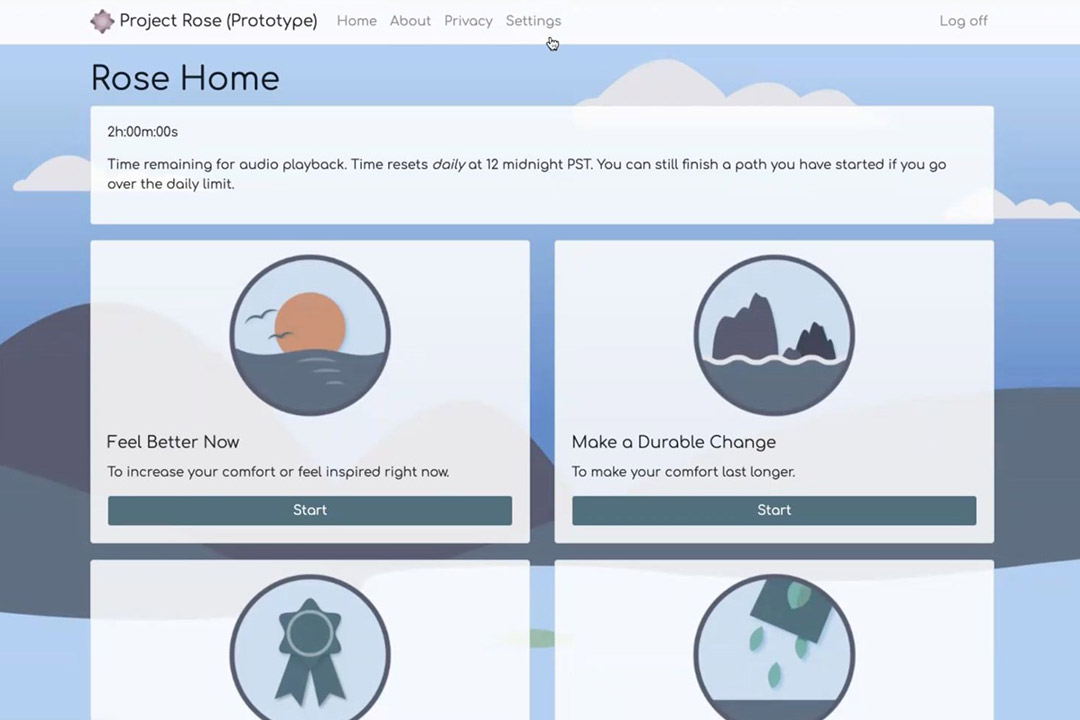RIT professors combine interactive media and hypnosis to ease pain
Researchers earn NIH grant to develop personalized hypnosis pain management application
HypnoScientific
Researchers have received a National Institutes of Health grant for their work to merge interactive media and hypnosis as a personalized pain management solution. The prototype dashboard pictured shows tailored hypnosis scripts that can be made available to the end-user.
Researchers from Rochester Institute of Technology and University of Washington are harnessing the power of interactive media and clinical hypnosis to help people manage pain without drugs. The team has received a National Institutes of Health (NIH) grant for the work and is spinning-out the technology for commercialization.
The new spin-off company—called HypnoScientific—is developing tailored self-hypnosis treatment scripts that can be delivered to people via digital therapy. A hypnosis script can be used as a guide for the best way to get reliable results. The researchers said their interactive media chronic and acute pain management methods can be used for modulating pain intensity and other outcomes, including mood, sleep, and hope.
“The goal is to increase access to these treatments and get them into the hands of as many people as possible,” said Owen Gottlieb, associate professor in RIT’s School of Interactive Games and Media. “Right now, it’s hard to find good clinical hypnosis and individualized care.”
HypnoScientific was awarded a Phase 1 NIH Small Business Technology Transfer grant, which establishes the scientific and technical merit and feasibility, as well as the potential for commercialization of the proposed research. The company is led by Gottlieb; Dr. Laurence Sugarman, research professor in RIT’s College of Health Sciences and Technology; and Mark Jensen, professor in the Department of Rehabilitation Medicine at the University of Washington.
The research began in 2017, after Gottlieb suffered a bad ski accident that resulted in broken bones and surgery. He had learned about therapeutic hypnosis during graduate school research and following the accident turned to the techniques to manage his pain.
“I came out of that experience realizing that I want to help other people access relief from pain,” said Gottlieb, who has experience designing mobile augmented reality games. “And why can’t people just open their phone or computer and have access to these skills and materials?”
At RIT, Gottlieb teamed up with Sugarman, who has worked as a pediatrician and has expertise in therapeutic self-regulation strategies. They then connected with Jensen, whose more than 40 years of clinical research focuses on the development and evaluation of psychological pain treatments, including hypnotic treatments.
Jensen explained that although analgesic pain medications and other traditional biomedical treatments can reduce pain temporarily, evidence is growing that they can result in long term increases in pain intensity. His research shows that many so-called “alternative” treatments—including cognitive behavioral therapy, training in meditation practice, and self-hypnosis—show the opposite pattern.
“They might not result in as much immediate pain relief, but as people use them, they can result in longer term and more durable reductions in pain with few negative side effects,” said Jensen. “Of these options, my research has shown that training self-hypnosis is the most effective and its ‘side effects’ are overwhelmingly positive—a greater sense of calm, improved sleep, feeling more hope, and feeling more in control.”
However, access to hypnosis can be out of reach for a majority of people who could benefit from the treatment. It often requires multiple treatment sessions by trained professionals and insurance does not always cover treatment. While there are many different hypnosis apps on the market today, the researchers said HypnoScientific’s work is designed and developed upon scientific research.
Seed funding from RIT’s Office of the Vice President of Research, RIT’s Golisano College of Computing and Information Sciences, and RIT’s MAGIC Center led to a prototype of the HypnoScientific pilot application. RIT research students working in full stack engineering, graphic design, animation, and sound editing helped to build the original prototype.
With the NIH funding, the team plans to test the efficacy of new HypnoScientific scripts and produce a minimum viable product. The clinical studies will help the team understand which scripts are most effective and how people like to access them. In the future, HypnoScientific plans to work with healthcare providers to deliver the treatment.
“Chronic pain is a serious problem worldwide, and modern medicine has failed to help the great majority of people with pain,” said Jensen. “We want to contribute to the reduction of suffering in the world in general and the suffering caused by chronic and acute pain, specifically.”
The HypnoScientific team is supported by CoVelocity, a health technology commercialization company founded by former executives in digital health who specialize in helping early stage companies get to market to serve the needs of patient populations. For more information, go to the HypnoScientific website.

